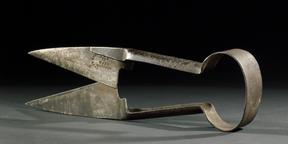


Fowler mole plough c.1920, steerable, for use with steam cable ploughing engines, by John Fowler & Co (Leeds) Ltd, Steam Plough Works, Leeds
The mole plough was a vital tool for improving the drainage of waterlogged fields. The plough was pulled across a field via cables running between two steam traction engines. The solid metal cylinder at the base of the plough - the mole - was dragged through the soil at depths of between 18 and 30 inches (45 and 76cm), forming a drain 3.5 inches in diameter through which excess groundwater could be drained away. Mole ploughing was much cheaper than laying drains by digging trenches, and did much to increase crop yields.
Details
- Category:
- Agricultural Engineering
- Object Number:
- 1983-889
- Materials:
- cast iron, wrought iron, steel (metal), paint and bronze (copper, tin alloy)
- Measurements:
-
overall: 2320 mm x 2350 mm x 6240 mm,
- type:
- plows
- credit:
- Roads, C. (Cambs)




